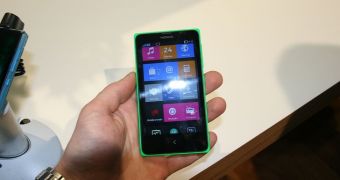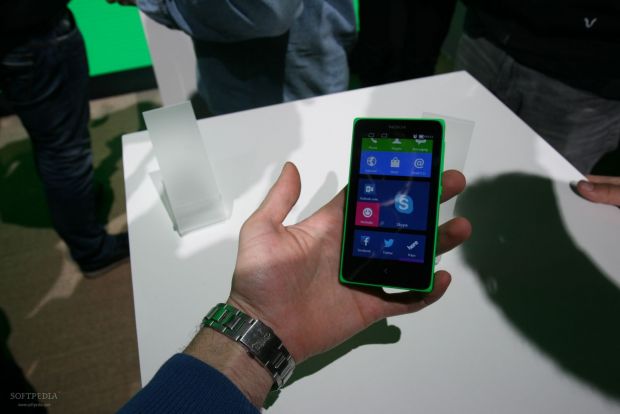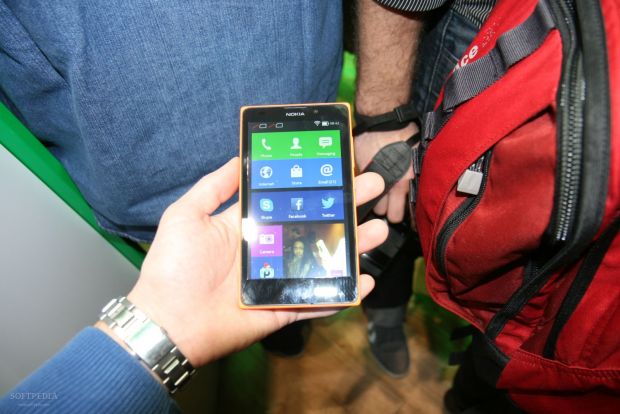Three weeks ago, Finnish mobile phone maker Nokia made a rather controversial announcement at the Mobile World Congress in Barcelona, Spain, by unveiling the first handset in its lineup to run under Google's Android operating system, namely the Nokia X.
The smartphone was revealed at a time when Nokia's devices division was preparing to move to Microsoft, after a few years during which the company sold the largest number of Windows Phone-based handsets out there, and came as a surprise to many.
Rumors on Nokia X circulated on the web for several months before the official announcement, yet some found it rather hard to believe that the vendor would indeed go for Android after getting so close to Microsoft.
And now that the phone is official and that it has already started to arrive on shelves in various markets around the world, people are wondering what will become of it.
Soon, Nokia will be part of Microsoft, and there's little chance that the Redmond-based company will accept in its lineup devices that are not running under its own mobile operating system, Windows Phone.
Despite that, Nokia appears determined to expand the lineup, and Jussi Nevanlinna, VP for Mobile Phone marketing, said it loud and clear on February 24, the day that Nokia X was announced, that additional devices were planned in the series in the next year.
In fact, Nokia X did not arrive alone right from the start, as two other smartphones running Android were unveiled next to it, namely Nokia X+ and Nokia XL. This means that, when speaking of the fate of one of them, we should be referring to all of them.
Nokia X to expand the mobile presence of Microsoft services
If there's one good reason for Microsoft to allow Nokia's X family of devices to continue to live is the fact that they feature its own services loaded on top, and not Google's products.
Google has almost full monopoly on the services loaded on Android devices, and that is a market that Microsoft is undoubtedly looking to expand to. Nokia X represents the perfect tool to do that.
As a matter of fact, this is one of the things that Nokia has been stressing upon ever since unveiling Nokia X. HERE Maps, Nokia MixRadio, and Microsoft services like Skype, Outlook.com, and OneDrive are what this handset has to offer.
No Google services were loaded on top of it, and it was a deliberate move, because this allows Nokia to push its own products, as well as Microsoft's, to Android. And this is exactly why Microsoft might agree to allow Nokia to continue launching Nokia X smartphones even after completing the acquisition.
At the moment, Microsoft is focused on mobile and services, and has said more than once that it puts cloud and mobile first. Clearly, it was not referring only to Windows Phone, as this platform's market share is reduced, but the company was thinking of the entire mobile space, which includes Android.
From this perspective, Nokia X plays a key factor in Microsoft's strategy, even if Joe Belfiore said at MWC that the company was not extremely happy with all things that the Finnish vendor had decided to do.
All three devices included in the X family of devices at the moment are aimed at the entry-level market, which means affordable price tags, thus capable of bringing Microsoft's services to the masses.
A great competitor for Windows Phone in the low-end market
One thing that is also certain about Nokia X is that it poses a great risk for Microsoft exactly due to one of its main features: the low cost.
The handset was designed to fit the needs of users in emerging markets such as India, China, Thailand, and others, and is expected to attract them courtesy of its affordable price tag, which could actually hurt sales of Lumia handsets in the entry-level segment.
For months, the most popular handset in Nokia's Lumia series has been Lumia 520, the cheapest in the family, and Nokia X will be a direct competitor to it, especially in those markets where Nokia's brand is still strong.
In fact, the handset has already started to prove a highly popular device among users out there, with over one million pre-orders received in China in only four days after the official launch.
There are a lot of affordable Android devices available on the market, yet the great initial interest that Nokia X has seen right from the start clearly shows that there's room for some more of them to appear.
Before the X family, Nokia was targeting this market segment with its Asha handsets, but they did not prove as successful as the company might have expected them to be. The new Android phones, however, have the potential of changing things in the handset vendor's favor.
Nokia X was designed mainly for people who have never had a smartphone before, but who wanted to grab one. It comes with a simple UI, a low price, and with services and apps that enable them to easily make the switch.
But it's not only Lumia phones that will be hurt by Nokia X in the entry-level segment. Microsoft has unveiled at MWC partnerships with other phone makers as well, including companies already known for their affordable Android devices, which will launch cheap Windows Phones too.
This includes Karbonn and Lava, both said recently to be receiving access to Windows Phone for free, in an attempt to make the platform more appealing to them. They might see Nokia X as a threat as well, that's for sure.
Nokia X may actually make Lumia successful
According to Nokia, however, the X family of devices was actually destined to bring users closer to Lumia handsets, and not to become a rival solution for them.
Despite its early success, which could continue moving forth (analysts estimated that over 14 million Nokia X devices might be sold this year), the new family of devices could help Windows Phone in the long run.
Microsoft might not be enthusiastic about the launch of Android-based Nokia devices, but, should the Finnish phone maker's strategy prove right, the Redmond software giant might actually have more to gain from the launch of these phones than initially believed.
The X family of devices is expected to offer the masses a glimpse at what a smartphone has to offer, making the move to a Lumia handset come more natural afterwards, Nokia said after launching these phones.
As can be deducted from this, this strategy is based on patience, as it would come to fruition only in one or two years, after the Nokia X devices become old and people start considering a refresh.
On the short term, we might see Nokia X rising and bringing more market share to Android, especially if the company launches some more handsets in the series.
In the long run, however, the phone maker might start touting the wider range of Nokia and Microsoft services that users would be able to enjoy when choosing Lumia over its Android devices, thus helping the Windows Phone ecosystem grow.
The Fastlane UI loaded on top of Nokia X, which comes from the Asha series, reminds many of Windows Phone, especially with icons/tiles such as those for HERE Maps, Skype, Outlook.com, and other apps and services that are present on Windows Phone already.
Nokia X is a risk that needs good management
In the end, Nokia X is a risk that Microsoft will need to manage carefully. Despite its good intentions, the handset, and all others in the series, could actually hurt Windows Phone through the very features that were aimed at helping it.
Nokia X is pushing Microsoft services to Android, but there are many enthusiasts who would rather have Google's products loaded on a device running under this mobile OS. In fact, people have already managed to root the handset and install Google apps on it.
Microsoft is betting a lot on cloud and services, and Nokia's Android smartphone could be its strongest point in this strategy, but it could also prove its weakest one, there's no doubt about it.
At the same time, Nokia X might create the need for smartphones at price points that Windows Phone won't be able to reach, despite the existence of Lumia 520 on the market.
The competition in the entry-level smartphone segment is undoubtedly going to increase, and Microsoft and its partners will need to supply handsets appealing enough to make Windows Phone stand out when compared to Android.
This means, however, that other entry-level Android devices pose as much of a threat as Nokia X does, and that Microsoft needs to consider them as well when setting up its strategy following Nokia's acquisition.
With Nokia X, the ball is in Microsoft's yard, and it remains to be seen whether it will play it right. Some believe that it will cancel the project the moment Nokia becomes one of its divisions.
I for one doubt that. It still needs to see how things will actually work for its mobile products with this device available on shelves, and it will certainly leave it there for a while, just to see how it goes.
Windows Phone is already on an ascending curve, and there's little chance that it will slow down soon, even with Nokia launching an Android handset. It still has a lot to catch up but, in my opinion, Nokia X won't pose much of a threat, despite the fact that things don't look this way at the moment.

 14 DAY TRIAL //
14 DAY TRIAL // 



